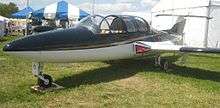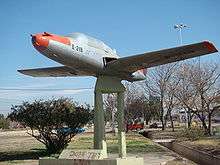Morane-Saulnier MS.760 Paris
| MS.760 Paris | |
|---|---|
.jpg) | |
| A MS.760 on the ramp of the Dryden Regional Airport (CYHD) | |
| Role | Trainer aircraft |
| National origin | France |
| Manufacturer | Morane-Saulnier |
| First flight | 29 July 1954 |
| Introduction | 9 February 1959 |
| Retired | 1997 (France), 2007 (Argentina) |
| Primary users | French Navy French Air Force Argentine Air Force |
| Number built | 165 |
| Developed from | Morane-Saulnier MS.755 Fleuret |
The Morane-Saulnier MS.760 Paris is a French four-seat jet trainer and liaison aircraft built by Morane-Saulnier. Based on the earlier side-by-side seating two-seat trainer, but adding another row of two seats, the MS.755 Fleuret, the Paris was used by the French military between 1959 and 1997. In 1955, a short-lived venture with Beech Aircraft to market the Paris as an Executive Business Jet in the US market[1] was soon eclipsed by Learjet’s Model 23. While four seat propeller planes are common, jet-powered planes with this seating arrangement such as the Grumman EA-6B Prowler are comparatively rare.
Design and development
In the early 1950s the French Air Force needed an ab-initio jet trainer; Morane-Saulnier proposed the MS.755 Fleuret, but the competition was won by the Fouga Magister. The company re-designed the MS.755 as a four-seat liaison aircraft which they called the MS.760 Paris.
On 29 July 1954 the prototype MS.760, registered F-WGVO (F-BGVO), took off on its maiden flight. With its T-shaped vertical stabilizer, low wing, and two Turbomeca Marboré II 400 kg turbines internally mounted side-by-side in the aft fuselage, the Paris offered a platform characterized by inherent stability. The aircraft had four seats, two in the front and two in the back, and a retractable tricycle landing gear.
The French military ordered 50 aircraft for liaison duties, for both the French Air Force (36) and Navy (14). The first production aircraft flew on 27 February 1958.
In 1961, production plants started rolling out the MS.760B Paris II, fitted with two Marboré VI 480 kg engines, wingtip fuel tanks, air conditioning, and a bigger luggage compartment. On 24 February 1964, a six-passenger version, designated MS.760C Paris III, made its first flight, but there was no production of this variant. Production of the Paris II ceased, and production of the Paris III never started. Some 153 aircraft (Paris I and Paris II) were produced for the French Air Force (36 planes) and Navy (14 planes), and the air forces of Argentina, and Brazil. Construction nr. (serial numbers) 109 and 110 were never built.
Operational history

On 18 July 1956 the French government requisitioned 50 aircraft, including 14 for the Navy, from Tarbes-based manufacturer Morane-Saulnier. The first plane was delivered on 9 February 1959 to Naval Air Station (N.A.S.) Dugny-Le Bourget, before going to the C.E.P.A. (directly translated as Aeronautical Practical Experiment Center - in English this would probably be "Flight Test Centre") in 1959-60, for the flight tests necessary to develop training programs and materials. The type was also purchased by several countries such as Brazil and Argentina; 36 planes were license-built by Fabrica Militar de Aviones (FMA) in Argentina. The MS.760B Paris II, with various systems improvements and integral fuel tanks in the leading edges of the wing, first flew on 12 December 1960.

A fleet of six MS.760Bs were flown on training duties by the Rijksluchtvaartschool based at Groningen Airport in the north of the Netherlands between September 1962 and November 1974.[2]
From 1958 to the early '60s an MS 760 was used as a flying classroom at the "Colledge of Aeronautics" Cranfield UK. The aircraft was equipped to study stability and control together with performance as part of the MSc course.
The 14 MS.760 were assigned to Flight 11.S from 9 February 1959 onwards. The last plane, No. 88, was delivered on 27 July 1961. In 1965, MS.760 No. 48 was briefly assigned to Flight 3.S based at N.A.S Hyères. From 1970 onwards, all the 12 remaining MS.760s were assigned to Flight 2.S based at N.A.S. Lann-Bihoué. In May 1972 they were sent to the S.R.L. On 1 September 1981 this unit became Flight 57.S (this flight had been shut down at the closing of N.A.S. Port-Lyautey, Morocco on 15 January 1962).
Their missions were Super Étendard and F-8 Crusader pilot IFR and all-weather training, advanced training for new pilots, proficiency training for other pilots and A.L.P.A. (admirals commanding the carriers and Naval Aviation), and 1st and 2nd Aerial Regions liaisons. Eight MS.760 Paris were on the unit's flightline. After 40 years of service, the aircraft were retired in October 1997 at Landivisiau Naval Air Station.
Argentine Air Force MS.760s were used in combat to suppress the 1963 Argentine Navy Revolt, bombing a rebel-held radio station as well as the Punta Indio naval airfield, destroying several aircraft on the ground.[3] In 2007, after 48 years of continuous service, the Argentine Air Force retired their last Paris.[4]
In 2009, JetSet International Ltd purchased more than 30 MS760s from the French and Argentinian governments, and the type certificate, tooling, parts, engineering plans and drawings[5] from Daher SOCATA. They are refurbishing the airframes and installing new jet engines and avionics and selling them for approximately $550,000.[6] A two-ship aerial demonstration team called Team MS760 Aerobatics using the refurbished aircraft was formed in 2009.[7]

Operators

- Argentine Air Force – 48, of which 36 were license-produced at Cordoba by FMA(c/n: 1A till 36A). Used between 1959–2007
- Brazilian Air Force - 30 assembled locally.
Survivors
- N° 08 & N° 09 Dave Bennett, a collector in Colorado
- N° 31 and N° 33 are preserved at the Rochefort Museum of Naval Aviation Traditions.
- N° 32 is owned by "Armor Aéro Passion" association
- N° 40 by the Le Bourget Air and Space Museum
- N° 42 by the Tristan Corbière Technical High School
- N° 46 by the Savigny-les-Beaume museum
- N° 76 by the Museu Aeroespacial - MUSAL - in Brazil (FAB 2932)
- N° 85 by the "Les Ailes de l'Aéro" association
- N° 87 and N° 88 were sold to private American owners
Specifications (MS.760 Paris I)
Data from Jane's All The World's Aircraft 1961–62[8]
General characteristics
- Crew: 2
- Capacity: 2 passengers
- Length: 10.05 m (33 ft 0 in)
- Wingspan: 10.15 m (33 ft 4 in) (over tip tanks)
- Height: 2.60 m (8 ft 6 in)
- Wing area: 18.0 m2 (194 sq ft)
- Aspect ratio: 5.12:1
- Empty weight: 1,945 kg (4,288 lb)
- Gross weight: 3,470 kg (7,650 lb)
- Fuel capacity: 950 L (210 imp gal; 250 US gal) in main tank, 450 L (99 imp gal; 120 US gal) in optional tip tanks
- Powerplant: 2 × Turboméca Marboré II turbojets, 3.9 kN (880 lbf) thrust each
Performance
- Maximum speed: 650 km/h (404 mph; 351 kn) at sea level
- Cruising speed: 570 km/h (354 mph; 308 kn) at 5,000 m (16,000 ft)
- Range: 1,500 km (932 mi; 810 nmi) at 7,000 m (23,000 ft)
- Service ceiling: 10,000 m (32,808 ft)
- Rate of climb: 11.50 m/s (2,264 ft/min)
- Take-off run: 750 m (2,460 ft)
Armament
- Guns: Provision for 2× machine guns in nose
- Rockets: Racks for 4× 90 mm rockets
- Bombs: 2× 50 kg (110 lb) bombs
See also
- Related development
- Aircraft of comparable role, configuration and era
References
| Wikimedia Commons has media related to Morane-Saulnier MS.760. |
- Notes
- Bibliography
- Dekker, Herman (1987). The Complete Civil Aircraft Reisters of The Netherlands. Tonbridge, Kent: Air-Britain (Historians) Ltd. ISBN 0-85130-139-8.
- Donald, David; Jon Lake (2000). The Encyclopedia of World Military Aircraft. NY, NY: Barnes & Noble. ISBN 0-7607-2208-0.
- Taylor, John W. R. (1961). Jane's All The World's Aircraft 1961–62. London: Sampson Low, Marston & Co. Ltd.
| ||||||||||||||
| ||||||